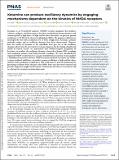| dc.contributor.author | Adam, Elie | |
| dc.contributor.author | Kowalski, Marek | |
| dc.contributor.author | Akeju, Oluwaseun | |
| dc.contributor.author | Miller, Earl K. | |
| dc.contributor.author | Brown, Emery N. | |
| dc.contributor.author | McCarthy, Michelle M. | |
| dc.contributor.author | Kopell, Nancy | |
| dc.date.accessioned | 2024-05-22T18:00:23Z | |
| dc.date.available | 2024-05-22T18:00:23Z | |
| dc.date.issued | 2024-05-20 | |
| dc.identifier.issn | 0027-8424 | |
| dc.identifier.issn | 1091-6490 | |
| dc.identifier.uri | https://hdl.handle.net/1721.1/155039 | |
| dc.description.abstract | Ketamine is an N-methyl-D-aspartate (NMDA)-receptor antagonist that produces sedation, analgesia, and dissociation at low doses and profound unconsciousness with antinociception at high doses. At high and low doses, ketamine can generate gamma oscillations (>25 Hz) in the electroencephalogram (EEG). The gamma oscillations are interrupted by slow-delta oscillations (0.1 to 4 Hz) at high doses. Ketamine’s primary molecular targets and its oscillatory dynamics have been characterized. However, how the actions of ketamine at the subcellular level give rise to the oscillatory dynamics observed at the network level remains unknown. By developing a biophysical model of cortical circuits, we demonstrate how NMDA-receptor antagonism by ketamine can produce the oscillatory dynamics observed in human EEG recordings and nonhuman primate local field potential recordings. We have identified how impaired NMDA-receptor kinetics can cause disinhibition in neuronal circuits and how a disinhibited interaction between NMDA-receptor-mediated excitation and GABA-receptor-mediated inhibition can produce gamma oscillations at high and low doses, and slow-delta oscillations at high doses. Our work uncovers general mechanisms for generating oscillatory brain dynamics that differs from ones previously reported and provides important insights into ketamine’s mechanisms of action as an anesthetic and as a therapy for treatment-resistant depression. | en_US |
| dc.description.sponsorship | National Institutes of Health (NIH) | en_US |
| dc.description.sponsorship | This work was generously supported by the JPB Foundation (E.N.B. and E.K.M.), the Picower Institute for Learning and Memory (E.N.B. and E.K.M.), the Simons Center for the Social Brain (E.K.M.), George J. Elbaum (MIT ′59, SM ′63, PhD ′67), Mimi Jensen, Diane B. Greene (MIT, SM ′78), Mendel Rosenblum, Bill Swanson, annual donors to the Anesthesia Initiative Fund; and the NIH Awards P01 GM118269 (N.K., E.N.B., and E.K.M.) and R01 NS123120 (E.N.B.). | en_US |
| dc.publisher | Proceedings of the National Academy of Sciences | en_US |
| dc.relation.isversionof | 10.1073/pnas.2402732121 | en_US |
| dc.rights | Creative Commons Attribution-NonCommercial-NoDerivs License | en_US |
| dc.rights.uri | https://creativecommons.org/licenses/by-nc-nd/4.0/ | en_US |
| dc.source | Author | en_US |
| dc.title | Ketamine can produce oscillatory dynamics by engaging mechanisms dependent on the kinetics of NMDA receptors | en_US |
| dc.type | Article | en_US |
| dc.identifier.citation | Adam, Elie, Kowalski, Marek, Akeju, Oluwaseun, Miller, Earl K., Brown, Emery N. et al. 2024. "Ketamine can produce oscillatory dynamics by engaging mechanisms dependent on the kinetics of NMDA receptors." Proceedings of the National Academy of Sciences, 121 (22). | |
| dc.contributor.department | Picower Institute for Learning and Memory | |
| dc.contributor.department | Massachusetts Institute of Technology. Department of Brain and Cognitive Sciences | |
| dc.relation.journal | Proceedings of the National Academy of Sciences | en_US |
| dc.eprint.version | Final published version | en_US |
| dc.type.uri | http://purl.org/eprint/type/JournalArticle | en_US |
| eprint.status | http://purl.org/eprint/status/PeerReviewed | en_US |
| dc.identifier.doi | 10.1073/pnas.2402732121 | |
| dspace.date.submission | 2024-05-21T17:59:54Z | |
| mit.journal.volume | 121 | en_US |
| mit.journal.issue | 22 | en_US |
| mit.license | PUBLISHER_CC | |
| mit.metadata.status | Authority Work and Publication Information Needed | en_US |
